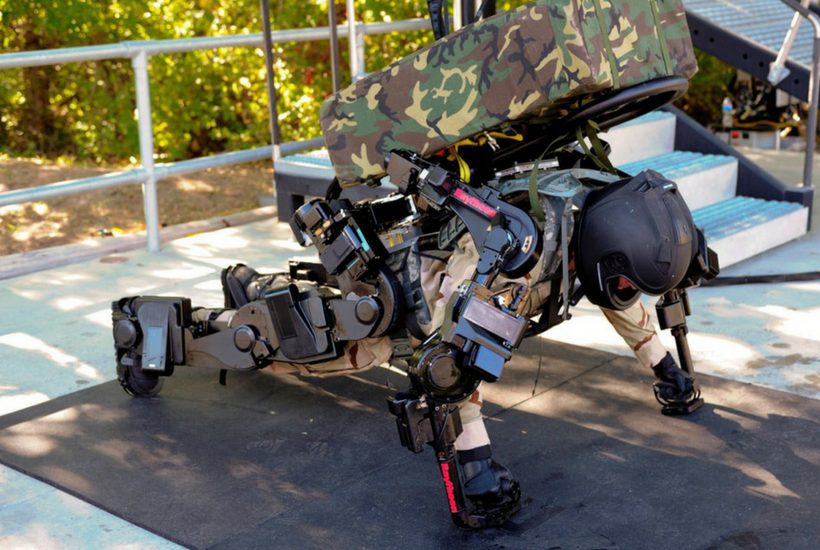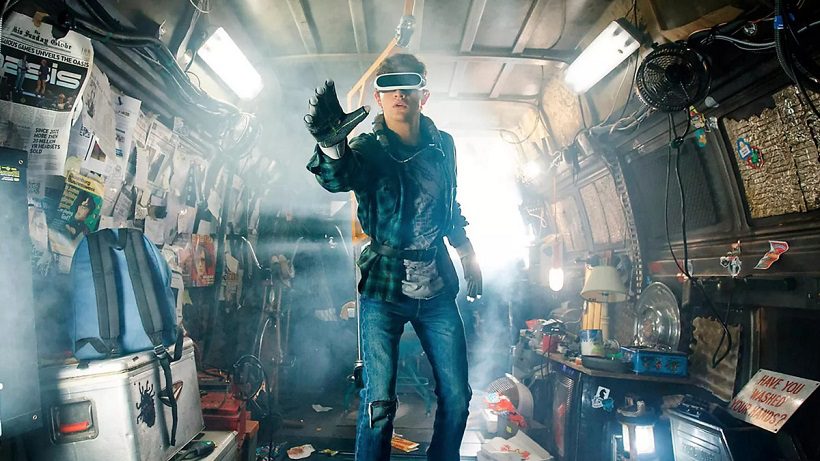At the start of the year, I set a reading goal based on how many books I read the previous year. I don’t define what kinds of books I’ll read, but a pattern sometimes emerges. This year is turning out to be a year of dystopian fiction and cyberpunk, not just in books, but also in film, television, and video games. In their bleak predictions of the future, they are wrong and they are right. It feels like we’re living in a cyber-dystopia.
Dystopia lays the foundation
The sale of dystopian novels spiked after Donald Trump won the 2016 Presidential election. George Orwell’s novel Nineteen Eighty-Four, which was first published in 1949, rose to the top of Amazon’s best-seller list. Aldous Huxley’s 1932 novel Brave New World also became a best-seller. Hulu’s web television adaptation of Margaret Atwood’s The Handmaid’s Tale helped the streaming service reach 20 million U.S. subscribers. The novel, which was first published in 1985, was Amazon’s most-read fiction book of 2017. Hulu doesn’t release ratings, but it reported that twice as many people tuned in to watch the premiere of season two of The Handmaid’s Tale. Hulu renewed the show for a third season.
Readers (and viewers) draw parallels between dystopian fiction and the current political environment in the U.S. (and in Australia, and perhaps in other countries as well). There’s talk of how we’re living under the kind of oppressive regimes these novels describe. We’re not, but it’s not all hyperbole either. We do live in a dystopia.

We have always lived in a dystopia. Dystopian fiction feels possible for readers because it draws from historical events. In the world of Nineteen Eighty-Four, people live under perpetual war, constant government surveillance, and propaganda. It’s a brutal world under a totalitarian or authoritarian regime following a betrayed revolution. Cults of personality, concentration camps, compulsory displays of support, and youth leagues are not just the stuff of fiction. We’ve seen them in Stalin’s USSR and Nazi Germany (and Cuba, I must add).
We’ve seen these themes in the U.S. too. The U.S. has been engaged in military conflicts for most of its history. During World War II, between 110,000 and 120,000 Japanese-Americans were relocated and incarcerated in concentration camps. In 2013, Edward Snowden’s disclosures revealed numerous government-run global surveillance programs. We see the personality cult that has developed around Donald Trump and the propaganda of InfoWars, Breitbart News, Fox News, and even the White House.
The Handmaid’s Tale explores the theme of female subjugation in a patriarchal society. Under a fundamentalist Christian military dictatorship, women’s rights are abolished and they are classed according to their reproductive capabilities. Like Orwell’s, it’s a brutal world, and Atwood didn’t make it all up. Writing for The Guardian in 2012, she said:
I made a rule for myself: I would not include anything that human beings had not already done in some other place or time, or for which the technology did not already exist. I did not wish to be accused of dark, twisted inventions, or of misrepresenting the human potential for deplorable behaviour. The group-activated hangings, the tearing apart of human beings, the clothing specific to castes and classes, the forced childbearing and the appropriation of the results, the children stolen by regimes and placed for upbringing with high-ranking officials, the forbidding of literacy, the denial of property rights: all had precedents, and many were to be found not in other cultures and religions, but within western society, and within the “Christian” tradition, itself.
In Brave New World, Huxley set out to satirise the utopian novels of H.G. Wells. The result is dystopia disguised as utopia. Instead of violence and fear, order in Brave New World is maintained through conformity brought about by genetic modification, conditioning, drugs, sex, and endless, mindless entertainment. Everyone is happy and productive, society is homogeneous and predictable, and consumerism keeps the world turning. The principles are based on Henry Ford’s assembly line (Ford is considered the creator of society). In Orwell’s Nineteen Eighty-Four, people are controlled by pain. In Huxley’s Brave New World, they are controlled by pleasure.
Comparing it to Nineteen Eighty-Four, in her introduction in the Penguin Vintage Classics edition of Brave New World, Atwood wondered which version of these futures would win.
During the Cold War, Nineteen Eighty-Four seemed to have the edge. But when the Berlin Wall fell in 1989, pundits proclaimed the end of history, shopping reigned triumphant, and there was already lots of quasi-some percolating through society. True, promiscuity had taken a hit from AIDS, but on balance we seemed to be in for a trivial, giggly, drug-enhanced Spend-O-Rama: Brave New World was winning the race.
That picture changed, too, with the attack on New York City’s Twin Towers in 2001. Thoughtcrime and the boot grinding into the human face could not be got rid of so easily, after all. The Ministry of Love is back with us, it appears, though it’s no longer limited to the lands behind the former Iron Curtain: the West has its own versions now.
On the other hand, Brave New World hasn’t gone away. Shopping malls stretch as far as the bulldozer can see. On the wilder fringes of the genetic engineering community, there are true believers prattling of the Gen-rich and the Gen-poor – Huxley’s Alphas and Epsilons – and busily engaging in schemes for genetic enhancement, and – to go Brave New World one better – for immortality.
Would it be possible for both of these futures – the hard and the soft – to exist at the same time, in the same place? And what would that be like?
Turns out it’s not hard to imagine. The hardness of Nineteen Eighty-Four and the softness of Brave New World do exist at the same time, in the same place, but there’s more: science and technology.
From dystopia to cyberpunk
Dystopia falls in the genre of speculative fiction. It may be included more broadly in science fiction, but whereas science fiction focuses more on creative scientific innovations that haven’t yet been developed, dystopian literature employs what’s already at hand. Science and technology don’t have a strong presence in the novels discussed above. To capture the modern dystopia, we need to look to another science fiction genre: cyberpunk.
If you’ve never read a cyberpunk novel, there’s a good chance you’ve seen a film in the genre. Think Blade Runner, The Terminator, RoboCop, and The Matrix. Cyberpunk and dystopia are both set in a future that has seen a breakdown in the social order. That’s pretty much where the similarities end.

Cyberpunk focuses on low life and high tech. Oppression in the world of cyberpunk is different than that of dystopian fiction. It’s not about order and conformity. The focus tends to be on misfits trying to get by. Inequality in cyberpunk looks a lot like modern inequality. What is notably different is that corporations have replaced governments as the centres of political, economic, and military power. Of course, the aesthetic is different too. The settings of dystopian novels are typically bleak and uniform. Cyberpunk is set in dense cities that glow with neon lights. Also notable is that much of the action takes place online and a typical trope is the direct connection between the human body and technology and cyberspace. Examples of this are technologically enhanced humans and the way that humans plug into the simulated world of The Matrix. Although it’s not quite edgy and noir enough to be truly cyberpunk, these elements can also be seen in Spielberg’s recent science fiction action adventure Ready Player One.
Does it sound far-fetched to say we live in a cyber-dystopia? Cyber-utopia and cyber-dystopia are used to refer to the world made better or worse by technological advancements. I’m not using it that way (and I tend to favour a more positive view of the Internet). I’m using the term in a literary sense to capture the elements of dystopia and cyberpunk and use them as a lens to view the world through.
Our world is one of perpetual war, constant surveillance, propaganda, continuous entertainment and distraction, corporatocracy, and integrated tech. The Internet is not something we can honestly continue to think of as being outside ourselves. We use the word “online” to describe our state of connectivity, but it has become unecessary. We are always online. Even when we are asleep, our smartphones, smart TVs, smart watches, and and so forth remain connected, sending information to Facebook, Google, Apple, Amazon, your telco, the government, and the creators of that sleep app you installed last week. Whatever you wrote, or someone wrote about you, on the Internet, remains. Banking, email, dating, photo sharing, video streaming, gaming… there’s a digital version of you and it will be there after you’ve died.

In fiction, we see imaginative and extreme examples of human enhancement technologies, but consider what is possible now: prosthetics and powered exoskeletons that enable those with disabilities to stand and walk and soldiers to carry 90 kg (200 lb) with little or no effort; artificial pacemakers, cochlear implants, and other medical implants that can replace, support, or enhance a biological structure. Even our computers and smartphones are used to enhance cognitive efficiency. It’s where we turn to find a phone number, to schedule an appointment, to remember to buy milk on the way home from work, if you’re still working in an office, that is.
Previously I said that cyberpunk and dystopia have little in common beyond both being set in a future that has seen a breakdown in the social order. The genres have another feature in common. They both intend to disquiet readers and call them to action. They encourage you to cultivate a sense of rebellion. Let us recall the words of Internet pioneer John Perry Barlow: “We will create a civilization of the Mind in Cyberspace. May it be more humane and fair than the world your governments have made before.”

